Menu
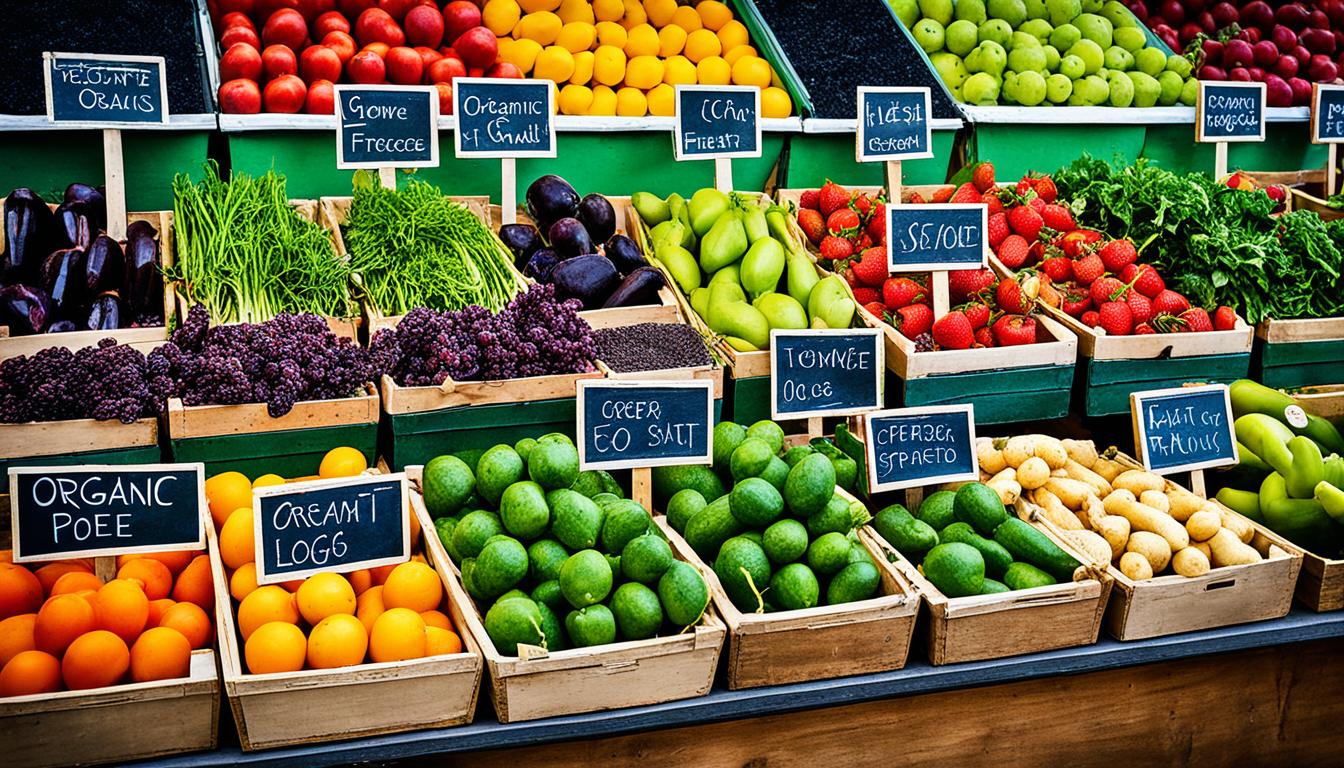
Did you know that over the last decade, organic grain prices have shown both upward and downward trends? This is very different from traditional markets, which are impacted by financial activities. The organic grain market is based on supply and demand. Not having a futures market for organic crops makes it harder for farmers to manage risks. Also, the U.S. often doesn’t have enough organic corn and soybeans to meet demand, so it relies heavily on imports.
My goal with this analysis is to give you a deep look into organic commodity prices. I’ll be using data from more than 50 grain buyers across the country. The analysis will also draw on information from the USDA and the Organic Trade Association. By looking into current trends in the organic market and how sustainable farming impacts prices, we can understand these markets better.
Organic grain prices don’t change as quickly as in regular markets. Figuring out the right prices takes longer in this market. It can also be hard to see what’s really going on because the organic market isn’t as clear. Even with these challenges, we have reliable sources like the National Organic Grain and Feedstuffs Report. They provide crucial organic grain price and volume data. This article will dive into current organic and non-GMO cash market prices, and historical and future pricing. The aim is to give a detailed view of the market.
Today, organic products are key in the farming world. They show why it’s important to price natural items correctly. Growing and making these items follows strict rules that avoid artificial chemicals.
The definition of organic commodities covers items made with strict organic rules. This means they’re made without fake pesticides or fertilisers. In the US, the organic food market made nearly $52 billion in 2018 (OTA, 2019). So, knowing about these items is crucial.
Market details about organic goods are very important. They help businesses and farmers understand changes in prices. For instance, the USDA says growing organic crops like corn and soybeans can bring in a lot of money. And the AMS found that organic dairy can sell for 16% to 210% more than regular products. This pricing info is key for making smart choices in the organic world.
| Commodity | Price Range |
|---|---|
| Organic Hay (per ton) | $885.00 – $890.00 |
| Organic Grain (per bushel) | $6.15 – $19.00 |
| Soybeans (per ton) | $888.48 |
| Soybean Oil (per pound) | $0.35 |
Studies by Mercaris and groups like MOFGA and OFARM help a lot by giving specific price information. They also suggest good prices to aim for. So, having a lot of knowledge about the market is really valuable for those involved in the organic field.
The cost of organic commodities changes because of many things. Things like how much people want them, the weather, and when they’re grown all have a big effect. Understanding these factors is key to knowing the current and future state of the organic market.
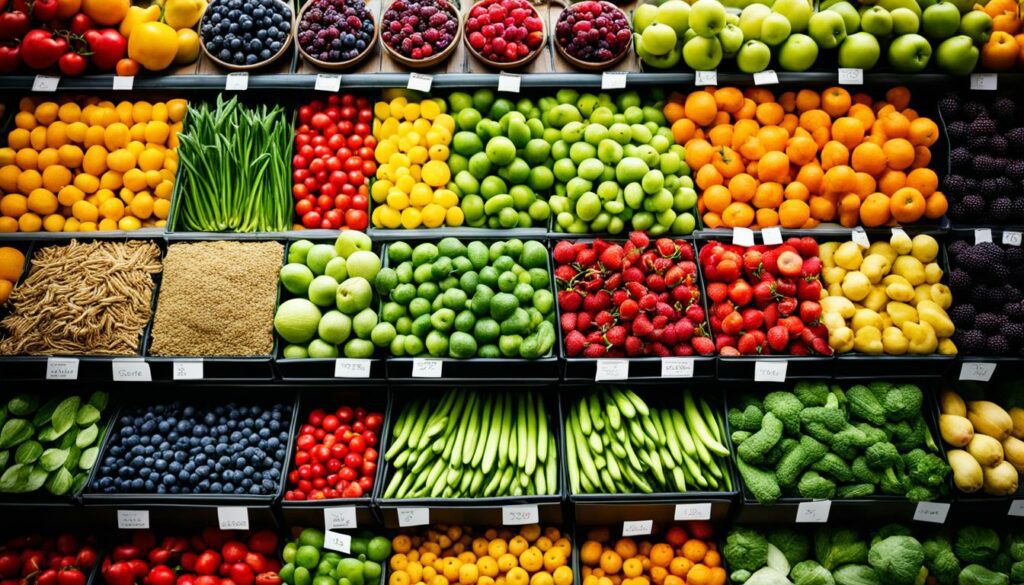
How much organic produce is made matches how much people want it. This link heavily affects prices. The organic food sector made an impressive $52 billion in sales in 2018. This high demand is clear. Yet, not being able to produce enough and having higher costs affects prices. As the USDA points out, things like organic corn, wheat, and soybeans can make a lot of money. But, as more is made, the prices could drop due to increasing volume.
Weather strongly affects organic market prices. The dry weather in the Prairies in 2023 was bad for both organic and non-organic crops. The low yield directly hit the market prices. For example, organic corn prices in Ontario fell from C$13-14 per bushel in December 2022 to C$11-11.50 in December 2023. The situation with organic wheat was similar, showing how organic farming is hit hard by the weather.
Prices in the organic market change with the seasons and farming cycles. Organic oat prices stayed quite steady, at around C$9.50-10 per bushel in December 2023. This was a bit higher than the C$8-9.25 per bushel they were in December 2022. This reliability shows a standard pattern in demand and supply. Besides, organic dairy items cost a lot more than regular ones, with prices being 16-210% higher back in July 2012.
Knowing how all these factors mix is vital for those in the organic business. It helps them make smart choices, use their resources at the right time, and predict market changes.
The United States Department of Agriculture (USDA) is key in organic commodity pricing. It does this through many activities. These include giving market insights and keeping strict organic farming standards.
The USDA uses market news reports to share important data. This data is about organic pricing, stock, and what people want to buy. In 2021, the U.S. sold over $52 billion in organic goods. This was about 5.5 percent of all food sales. Knowing this helps businesses plan for today and the future.
The USDA’s National Organic Program (NOP) helps keep organic goods genuine. It sets rules so organic food meets standards. This matters a lot for trust and value. From 2011 to 2021, the number of certified farms grew by over 90 percent. These rules help organic goods sell, like the $11 billion from farms in 2021.
The history of organic prices is full of changes and interesting events. These shifts have greatly affected how the market works and what things are worth.
In 2018, the organic food industry made almost $52 billion. But in 2021, this number fell slightly due to the economy. For example, organic strawberries cost 74 to 88 percent more than usual during certain times.
Big events in the organic market like new rules and the pandemic have changed prices. Rules about what’s truly organic make products more reliable but sometimes pricier. When everyone wanted more organic food in the pandemic, prices went up because there wasn’t enough to go around.
Better ways of growing organic food have also affected prices. A study in 2015 showed how new farming methods have led to changes in the prices of corn, wheat, and soybeans.

According to AMS data, fresh organic produce always costs more than the regular kind. For dairy, you could be paying anywhere from 16% to 210% more for organic. In places like Pennsylvania, where a lot of organic mushrooms are grown, this shows in the overall market. The U.S. had 4.9 million certified organic acres in 2021, a lot more than the 3.6 million in 2011. This growth in land and production has changed how we see and buy organic food.
| Year | Organic Retail Sales ($B) | Certified Organic Acres (Million) | Market Event |
|---|---|---|---|
| 2011 | – | 3.6 | – |
| 2018 | 52 | – | Peak Market Growth |
| 2020 | 53* | – | Inflation-Adjusted Peak |
| 2021 | 52 | 4.9 | Pandemic Impact |
The story of organic prices shows the market is always changing. Even though there are ups and downs, the trend is mainly upwards. Anyone involved in selling or buying organic food needs to watch out for the past and what might shake things in the future.
Looking at regional organic price variation shows some interesting points. The Pacific region, led by California, stands out. California made up about 43% of all organic sales in 2012. This is because many farms there use organic methods and there is high demand.
The Corn Belt saw a rise in organic sales from 6% to 8% between 2012 and 2021. This shows changing consumer tastes and growing local organic markets. In terms of direct sales, California sold 20% of its produce this way, but Indiana sold only 1% directly.
Different factors, like transport costs and local interest, play a big role. Organic food from far away might be more expensive to cover the cost of transport. Also, local demand can change, affecting prices. This is why sales moved from natural food stores to regular grocery stores, which sold 55.6% of all organic food in 2021.
The government is putting more money into organic research. In 2023, $50 million is going to this cause, a big jump from $3 million in 2002. This could change how organic farming works, which might also affect prices.
| Region | Organic Sales (%) | Direct-to-Consumer Sales (%) |
|---|---|---|
| Pacific (California) | 43 | 20 |
| Corn Belt | 8 | 1 |
| National (varied) | 55.6 (via conventional retailers) | 6.5 (via internet sales) |
Organic farming is growing in the United States. By 2021, there were 4.89 million acres of certified organic land. This shows a steady increase since 2000. Although organic farms are less than 1% of all U.S. farms, they make up about 3% of all farm sales. This is good news for the economy.
So, organic prices vary a lot due to local conditions. These include demand and the cost to get the food to market. Knowing about these factors is important for those in the organic food business.
Organic hotspots are areas with lots of organic farming. They are good for the environment and our health. But their good effects don’t stop there. They also help local economies a lot, as shown by different studies.
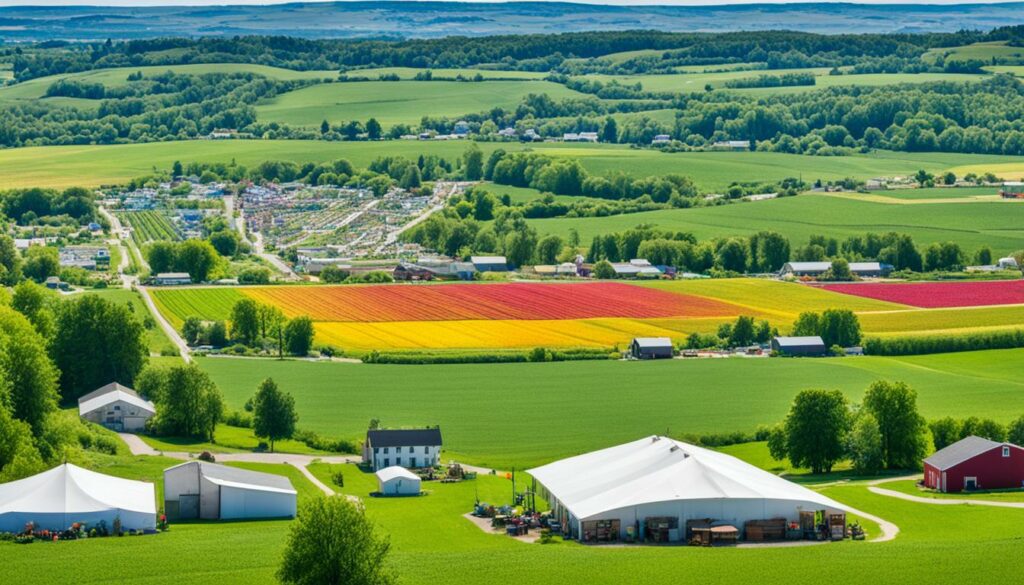
A study found 225 U.S. counties known as organic hotspots. These places had a lot of organic farming and their economies got better. In these organic hotspots, people made more money and were less poor. Just being in an organic hotspot raises household income by more than $2,000.
There’s also less poverty in these areas. Organic hotspots have poverty rates that are 1.35 percentage points lower than others. This is a big step in helping communities and making them stronger.
But, counties known for general agriculture don’t see such big benefits. In these places, the poverty rate only drops by 0.17 percentage points. And the rise in household income is just $75. It shows clearly how important organic farming is for the economy.
The impact is bigger still. Organic food sales in the U.S. keep growing fast. This growth is faster than the general food market. It helps local economies get stronger, raising incomes and lowering poverty in organic hotspots.
The Organic Industry Survey by the Organic Trade Association underscores the long-term benefits organic hotspots bring to local economies.
Organic hotspots had a remarkable effect on economies last year, after people started shopping more stably. As these areas grow, they make strong and lasting economic benefits possible.
The debate about organic vs conventional pricing mainly looks at retail prices. Organic products are often more expensive. This is because they have fewer supplies and their production is more costly. Knowing why the prices differ is important.
In early 2011, organic items cost about 68% more than non-organic ones. Organic ground beef might be 134% more expensive than conventional types. But surprisingly, organic brown rice can be 10% cheaper.
At farmers’ markets, organic lettuce is usually priced lower, around $3.00 per head. A dozen organic eggs might cost close to $4.40, which is only 5% more than the supermarket.
Many things lead to the different costs of organic and conventional produce. For example, organic food costs more because of expenses related to protecting the environment. It also includes higher standards for animal welfare.
The cost of organic food might decrease in the future. This could happen with more technology and larger production.
The prices of organic and non-organic food can differ a lot. Organic food in developing countries might cost the same as regular food. This shows local shopping habits. But, in developed countries, non-organic organic food prices might be much higher. This is because people are willing to pay more for quality goods.
| Item | Organic Price | Conventional Price | Price Difference (%) |
|---|---|---|---|
| Brown Rice | $2.50/lb | $2.77/lb | -10% |
| Ground Beef | $7.51/lb | $3.21/lb | 134% |
| Lettuce (Farmers’ Market) | $3.00/head | $3.66/head | -18% |
| Dozen Eggs | $4.40 | $4.19 | 5% |
The world of organic grains is both complex and ever-changing. It’s all about the buyers, sellers, and the people in-between. Knowing how this market works is crucial for anyone looking to sell or buy eco-friendly products.
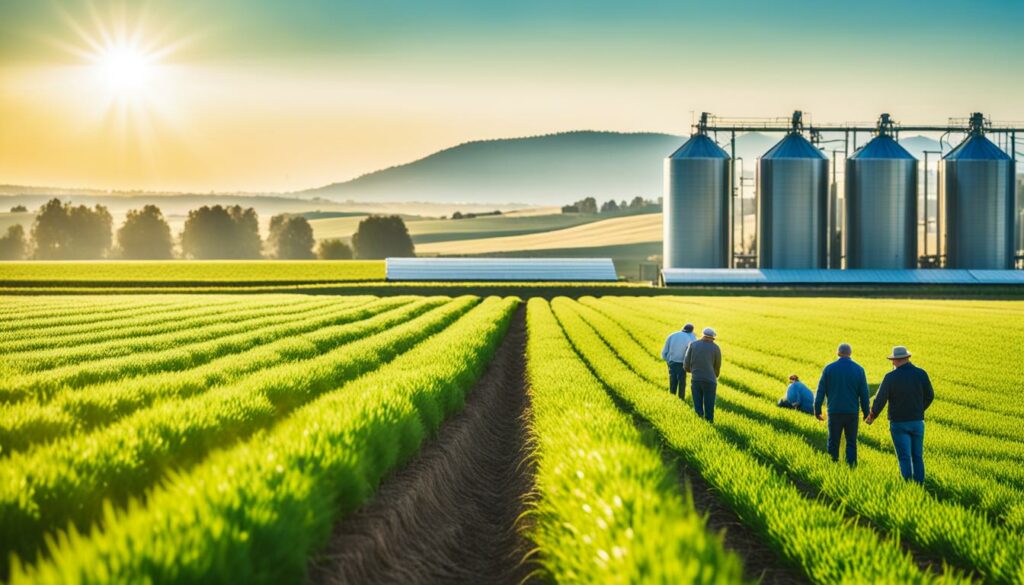
In the organic grain world, there are some important people. Producers, distributors, and sellers are key. There’s also the Organic Farmers Agency for Relationship Marketing (OFARM). They help set fair prices for grain, dairy, and livestock. All of these groups play a big part in how the market moves and the prices it sets.
Keeping up with the market is important. For example, the USDA reports on the prices of organic hay and grain. They say that organic hay has sold for $885.00 – $890.00 this year. Grain prices vary a lot, going from $6.00 to $19.00 per bushel. This detailed info helps people understand the current market.
Right now, organic soybean oil costs $0.35 a pound. Soybean meal is at $888.48 per ton. There are different prices for organic beans, like garbanzo and pinto. The USDA greenlights almost $52 billion in the U.S. for organic food sales in 2018. This shows how important the organic sector is.
| Commodity | Price Range | Market Volume |
|---|---|---|
| Organic Hay | $4.50 – $7.00 per unit | N/A |
| Wheat | $6.15 – $7.50 per bushel | N/A |
| Durum Wheat | N/A | 4,037.00 bushels |
| Soybeans | N/A | 1,042,569.93 bushels |
Reports show steady interest in organic feed corn and soybeans. However, their prices have dropped this year. Organic feed corn is 92 cents cheaper, and soybeans cost 10 cents less. Recent drought monitor data also notes heavy rain in some areas. This has affected markets and their prices.
Understanding these details is key for those in the organic grain world. It’s important to know about the key players and to follow the latest market news. This helps people in the organic grain business make smart choices.
Organic farming costs more because it follows strict standards and uses eco-friendly methods. These organic production costs pay off because they benefit the environment and can earn good money back.
Growing things organically means using special seeds, compost, and natural ways to deal with pests. The USDA says producing organic corn, wheat, and soybeans can make a lot of money. This shows that using sustainable methods is a wise choice.
People are willing to pay more for organic dairy products, like milk and butter. This is shown by the extra money organic farmers get, according to the AMS. Organic products may cost more to make, but they attract more buyers, as seen in retail data from MOFGA.
| Product | Organic Cost | Non-Organic Cost |
|---|---|---|
| Brown Rice | $2.50/kg | $2.75/kg |
| Oatmeal | $0.16/oz | $0.17/oz |
| Lettuce (Farmers’ Market) | $3.00/head | $3.54/head |
Organic farming is more than a money-making venture. It helps keep our planet healthy in big ways. By avoiding harmful chemicals, organic farming protects wildlife, keeps soil rich, and lowers pollution. This link between cost and environmental care is key to the value of organic farming.
The organic food market, worth over $52 billion in 2018, is a serious supporter of the planet. It puts money into things like rotating crops, cover crops, and not tilling so much. These actions help nature thrive.
The retail world plays a huge role in setting organic commodity prices. In the last ten years, the amount of land for organic farming has gone up by 79 percent to 3.6 million acres. At the same time, we have over 90 percent more certified organic farms, now at 17,445. This has a big effect on how organic products are priced in stores.
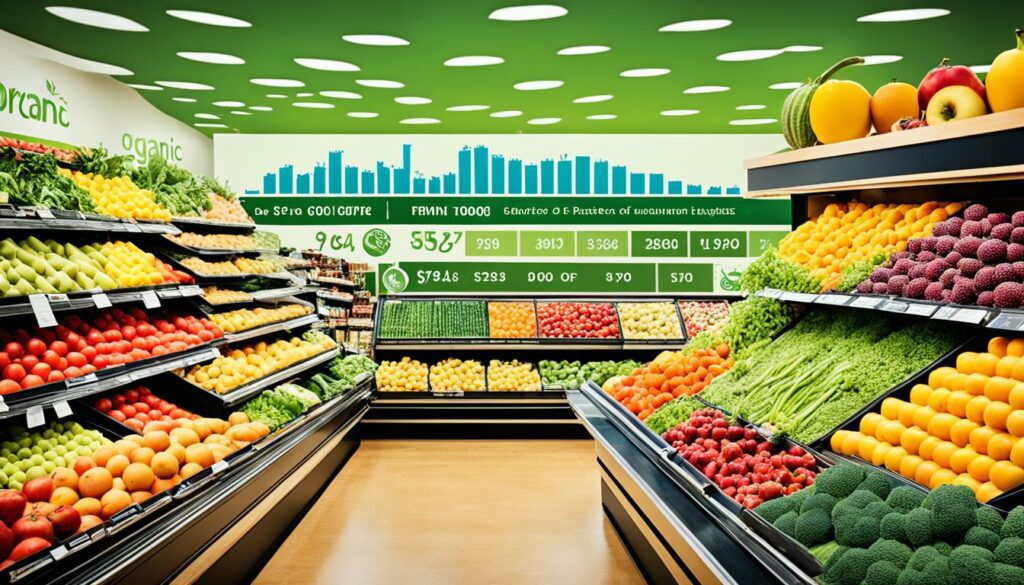
>Stores like traditional grocery shops, club stores, and supercenters now sell 56 percent of all organic foods by 2020.
The U.S saw its organic food sales grow by 8 percent yearly, hitting over $52 billion in 2021. This growth means organic foods now make up 5.5 percent of all food sales. Such big numbers make how they set prices important for consumer pricing dynamics.
Mostly, sales are in fresh fruits and veggies, making up 40 percent of the U.S. organic market in 2021. Dairy and eggs come next at 13 percent, then beverages at 12 percent, and packaged foods follow at 11 percent. These products usually cost more than non-organic options, showing how important consumer pricing dynamics are.
People who buy organic foods are from all age groups, but millennials buy more than the older generations. This demand from younger people pushes retailers to change how they sell these products. It plays a big part in how organic food prices are set in stores.
There’s a big demand for some organic products, like grains and oilseeds, but not enough grown locally. So, more of these goods are being imported to meet the demand. This shows how closely linked retail and organic pricing are.
The Organic Trade Association (OTA) gives a deep look into the organic world. They find out key trends through surveys and studies each year. It helps everyone understand what’s happening in the industry better.
The U.S. organic market has been on the rise for over 20 years, according to the OTA. The survey in 2021 showed people are now buying more normally. This is after a year of over-buying and shortages because of the pandemic. Understanding these buying trends is important for the future.
The OTA also shares the Organic Market Basket tool. It tells us about how much organic food is sold and the prices in the U.S. This information helps shops and farmers change what they sell. They do this to keep up with what people want to buy, making the market work better for everyone.
The OTA found that lots of young people buy organic food. In 2017, their survey showed that Millennials lead in choosing organic. This shows young people are choosing healthy, organic foods more often.
Moreover, a study on organic farming shows it’s good for local economies. Places with more organic farming have more money for local people and less poverty. This shows the benefits of the organic movement go beyond just health.
| Year | Global Organic Retail Sales (in billion $) | Total Organic Crop Area (acres) | U.S. Organic Imports (in billion $) | U.S. Organic Exports (in million $) |
|---|---|---|---|---|
| 2016 | $94 | 144 million | $17.6 | $553 |
| 2019 | $126 | 179 million | $25 | $647 |
| 2020 | N/A | N/A | $25 | $732 |
The organic market is growing fast, as shown by the OTA’s data. By keeping watch and learning from these trends, companies can plan better for the future. This makes the organic sector healthier and more reliable.
Organic commodity prices are set to shift in interesting ways. For example, in Ontario, organic corn prices dropped to C$11-$11.50 per bushel from C$13-14. This shows changes happening across the board. In Mossbank, Saskatchewan, organic wheat prices also decreased because of slow sales.
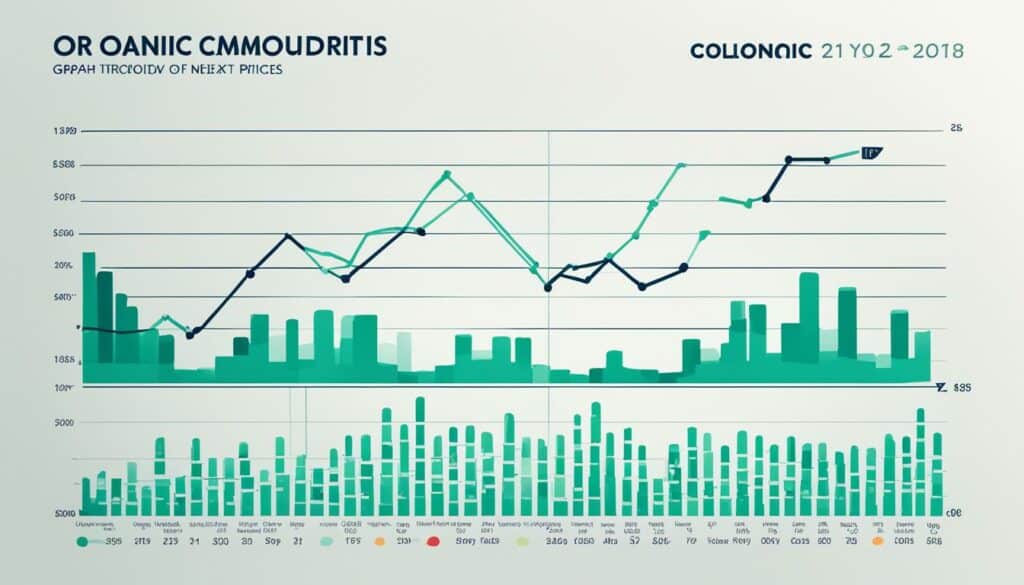
In Yorkton, Saskatchewan, demand for organic oats remains steady. A better economy might lead to even more demand. Next year, we can expect to see more organic oats planted as supplies get tighter, which is good news for this area. Despite dry weather affecting all crops, there was improvement thanks to better weather later in the summer.
Organic spring wheat prices have gone down from last December in a drop from C$22-$25 to C$18.50-$20 per bushel. Meanwhile, oat prices remained pretty much the same, going from C$8-9.25 to C$9.50-10 per bushel.
It’s not just these products that are growing. The amount of land certified as organic in the U.S. has jumped to 4.89 million acres. And sales of organic products now make up about 3% of farm earnings. This all shows how much more people want organic items.
On top of this, the government is putting more money into studying organic farming. Funding for this research shot up to $50 million in 2023 from just $3 million in 2002. This big investment points to a bright future for organic agriculture.
In sum, organic commodity prices are complex and require a comprehensive look. The organic food industry saw a boost to almost $52 billion in 2018. This data comes from the Organic Trade Association (OTA). Key drivers behind these figures are production costs, supply chain issues, and the hard work of organic farmers.
In 2015, the USDA noted that choosing organic farming can be financially rewarding. This is especially true for main crops like corn, wheat, and soybeans. Local groups such as the Maine Organic Farmers and Gardeners Association (MOFGA) and the Organic Farmers Agency for Relationship Marketing (OFARM) share vital pricing information.
It’s crucial to follow national and local pricing trends for sustainable growth. Mercaris, Inc., and OGRAIN help by offering deep insights and price details. They collect data from more than 50 first-handlers and local grain producers. The global market will value around USD 208.19 billion in 2022. This shows how important these insights are for driving future progress and innovation.
As the desire for organic food grows, understanding both the upsides and downsides is vital. Hence, focusing fully on organic agriculture brings strategic advantages and challenges. My last thoughts on this matter highlight the key benefits and hurdles of going organic.
It’s the cost of goods produced according to strict organic standards. These standards often mean no synthetic pesticides or fertilisers.
These insights show the trends that influence prices. They help people involved in the industry understand why organic good prices change.
The basic laws of supply and demand greatly affect pricing. When people want more than there is available, prices go up. But if there’s too much and demand is low, prices drop.
The weather plays a big part as it affects how many crops are available. Bad weather lowers supply and raises prices. Good weather can do the opposite.
The USDA keeps the National Organic Program and reports on the market. These help set the prices by making sure products meet organic standards.
Over time, prices have changed because of new rules, market surprises, and better tech. These have all affected the worth of natural products.
Yes, the cost can vary by region because of transport, how much people want them, and the number of organic farms. This leads to different prices and costs between places.
Areas with lots of organic farming boost the economy. They help make incomes better and fight poverty more than regular farming does.
Producing organic food is more costly. This is because of different farming methods and stricter standards. The price reflects making food in an environmentally friendly way.
Buyers, sellers, and those in between are important. They help set the prices and how the market works. They make sure eco-friendly products are available.
Costs include buying special seeds and improving the soil. These also help the market value green practices more and keep resources sustainable.
Retailers decide how much we pay for organic products. Their prices can make organic goods more or less affordable.
The OTA’s surveys tell us about the market’s size and what people buy. They give us a look into how organic products are bought and sold.
Prices for organic goods will likely keep going up. This is because more people want them and more land is used for organic farming. It shows growth in sustainable agriculture.